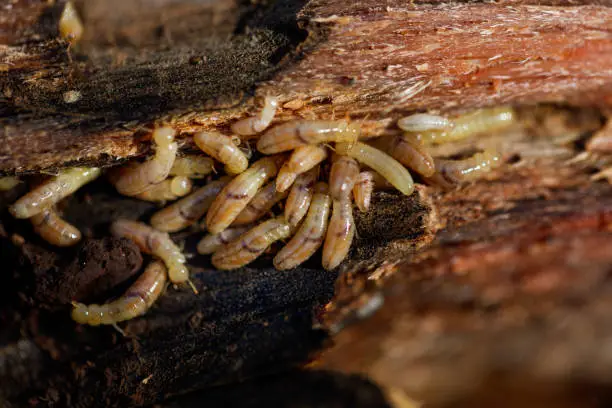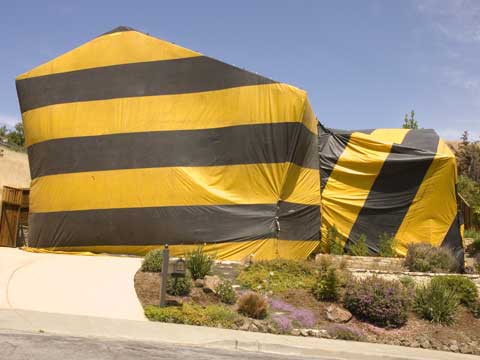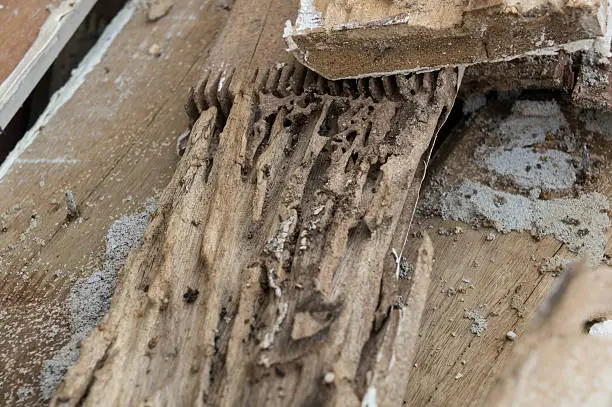Professional Termite Treatment Service in Riverside, CA
Southland Pest Control is Riverside's premier termite treatment service with over 30 years of experience in the pest control industry.


Get Your FREE Quote
Identifying Your Termite Infestation
When you need termite treatment in Riverside, understanding your enemy is the first step. First, you have subterranean termites. These bugs live deep in the ground and rely on soil for moisture, so they build mud tubes to move from the earth into your home. Also, they consume soft wood fast, causing serious damage quickly. But there is another type: drywood termites. Unlike subterranean termites, they live fully inside the wood they eat. Instead of mud tubes, they leave behind tiny, hard, six-sided droppings called frass. However, whether you see mud tubes or frass, you must act fast. In short, our Riverside Termite Treatment Service helps identify and eliminate both types with precision. For more helpful information, you can review termite biology and behavior from the University of California Statewide Integrated Pest Management Program. Finally, we provide guaranteed termite treatment right here in Riverside to keep your home safe and sound.
Termite Control in Redlands
Redlands’ historic homes and mature landscaping make it one of the highest-risk areas for termite activity in San Bernardino County. If you own property in Redlands, schedule a termite inspection with our local team.
Termite Red Flags Knowing Subterranean from Drywood
When you need termite treatment service in Riverside, you should know the specific warnings each type of termite leaves behind, because treating them requires a different plan. First, subterranean termites are soil dwellers, so they build distinctive mud tubes for protection. Also, look for piles of dark shed wings near your foundation, since they often swarm during the day. But drywood termites leave behind different clues. Instead, they create tiny exit holes to push out hard, six-sided droppings called frass. Furthermore, their swarmers are usually lighter brown and appear at night, often around windows. However, seeing any of these red flags means you must act fast! Finally, Southland Pest Control understands these signs well and delivers expert termite treatment right here in Riverside.
Recognizing the Warnings
- Mud Tubes: A telltale sign of subterranean termites traveling from the soil.
- Frass Pellets: Tiny, hard droppings indicating an infestation of drywood termites.
- Shed Wings: Dark wings mean subterranean termites; light wings mean drywood termites.
- Fully Licensed & Insured
- Locally Owned & Operated
- 5 Star Rated Service
- Customer Satisfaction Guarantee
- Emergency Services Available
- Professional Trained Technicians

Licensed Technicians
in Riverside
Termite Treatment Follow-Up Services
Emergency Termite Treatment Service
Understanding Termite Threats for Riverside Homes
When seeking a Riverside termite treatment service, it’s crucial to understand the two main types of termites found in local homes. Southland Pest Control handles both, but their signs and solutions are very different. Therefore, knowing the clues helps us quickly choose the right plan for your home. First, subterranean termites live underground and rely on soil contact to survive. Second, drywood termites live entirely inside the wood they consume. But whether you notice blistered wood, mud tubes, or piles of frass, we provide targeted termite treatment that protects your home from all invasive species.
Riverside Drywood Termite Signs: Frass, Damage & What to Look For
The Drywood Termite presents a unique and hidden threat because it lives entirely inside your wooden structure, requiring absolutely no soil contact. Therefore, you will never find mud tubes associated with this pest. Instead, the main evidence is tiny piles of six-sided droppings called frass , which they actively push out of the wood. Also, their internal tunneling can cause the wood surface to look strangely blistered. Finally, effective termite treatment targets the wood itself, and Southland Pest Control provides proven solutions for complete Drywood Termite elimination, including fumigation and spot treatments, right here in Riverside.
Drywood Termite Signs & Treatment
Smaller Infestation (Localized)
- Sign: Frass Pellets Tiny, hard, six-sided droppings resembling sand, found below a specific, isolated piece of infested wood.
- Treatment: Localized Spot Treatments Used for smaller, easily accessible infestations by injecting product directly into the wood where frass is found.
Bigger Infestation (Widespread)
- Sign: Blistered Wood Surfaces that look cracked or separated without any evidence of water damage, often indicating extensive, hidden tunneling.
- Treatment: Fumigation (Tenting) Recommended for widespread, large-scale infestations across the entire structure, as blistering often means the damage is too extensive to treat locally.
Riverside Subterranean Termite Control: Signs & Treatment
Therefore, when you need termite treatment in Riverside, subterranean termites present a major threat because they live underground. These pests must create mud tubes on your foundation to travel and keep moisture high. Also, they cause rapid, extensive damage, often leaving wood looking weak and hollowed (honeycombed). Because their colony is located in the soil, the best treatment involves immediate foundation defense. We establish a liquid barrier around your home or install advanced baiting systems for total colony elimination. Finally, trust Southland for guaranteed termite treatment right here in Riverside.
Subterranean Termite Signs & Treatment
Smaller Infestation (Localized Swarm)
- Sign: Dark, Shed Wings Piles of uniform, dark wings found near windows or foundation cracks, indicating a new, smaller swarm has occurred.
- Treatment: Localized Liquid Treatment A limited, targeted application of termiticide to a small area of the soil where the mud tubes are entering the structure.
Bigger Infestation (Active Tunnels)
- Sign: Mud Tubes Pencil-sized dirt tunnels found along foundations, walls, or in crawl spaces, proving active travel between the soil and the structure.
- Treatment: Full Perimeter Baiting or Barrier Recommended for active tunnels and established colonies, using comprehensive bait systems or a complete liquid soil barrier around the entire property.
Guaranteed Termite Treatment Solutions for Riverside Homes

Termite Fumigation
Whole-Structure Eradication
For severe or widespread infestations, whole-structure fumigation eliminates termites throughout your entire property. Our tent fumigation service includes a 3-year warranty and is the most effective option when termite activity is extensive or hidden in walls and attics. We handle all preparation guidance, tenting, treatment, and clearance so you can return to a termite-free home.
Heat Termite Treatment
The Chemical-Free, Same-Day Option
Heat treatment offers a chemical-free alternative for termite extermination. This method raises the temperature inside the structure to levels that are lethal to termites, ensuring they are eliminated without the use of pesticides. Unlike fumigation, heat treatment can be completed in just a few hours, and occupants can return to their home on the same day. It’s a popular choice for Riverside homeowners who want fast, effective results without vacating for days.


Localized Spot Termite Treatments
Targeted and Convenient
For smaller or isolated termite activity, localized spot treatments are the ideal solution. Riverside homeowners often choose this option for minor infestations in door frames, window sills, or single pieces of furniture. After a detailed inspection, our technicians apply a specialized, targeted treatment directly to the infested wood. This method is cost-effective and requires little to no preparation from the homeowner. Furthermore, since you do not need to evacuate your home, it is the most convenient option for dealing with smaller infestations.
Orange Oil Termite Treatment in Riverside
Natural, Eco-Friendly Spot Control
Orange oil is a natural, eco-friendly solution that eliminates termites without using traditional pesticides. This quick, non-invasive treatment works by injecting the orange oil directly into the exposed infested wood, where it kills termites and their eggs on contact. Because this is a low-impact method, you can remain in your home during the process, making it a popular choice for Riverside homeowners in Wood Streets, Canyon Crest, and Mission Grove who want effective termite control without harsh chemicals.

Get Your Free Termite Treatment Quote from Southland Pest Control
Our team is fully trained and licensed to secure your home from invasive termites.
Areas We Proudly Serve for Termite Treatment
Aguanga, Anza, Arlington, Banning, Bell Canyon, Bloomington, Cabazon, Calimesa, Canyon Lake, Casa Blanca, Cherry Valley, Coronita, Crestline, De Anza Village, Devore, East Hemet, El Sobrante, Gavilan Hills, Glen Ivy, Good Hope, Grand Terrace, Green Acres, Highgrove, Home Gardens, Homeland, Idyllwild–Pine Cove, La Sierra, Lake Arrowhead, Lake Hills, Lake Mathews, Lake Norconian Club, Lake Perris, Lake Riverside, Lakeland Village, Lakeview, Loma Linda, Mead Valley, Meadowbrook, Mentone, Mountain Center, Muscoy, Nuevo, Pedley Hills, Quail Valley, Ramona, Romoland, Running Springs, Temescal Canyon, Temescal Valley, Valle Vista, Warm Springs, Winchester.
Year-Round Protection: Our Monthly Pest Prevention & Management Service
Why Choose Our Riverside Termite Treatment Services
- Licensed Termite Treatment Experts in Riverside
- Locally Owned & Trusted by Riverside Homeowners
- 5-Star Rated Termite Extermination Services
Follow-Up Treatments That Ensure Protection
After your first service, our Riverside termite treatment service team provides follow-up visits to check results and prevent future problems. These regular inspections help ensure your home stays termite-free all year long.
We offer monthly, bi-monthly, and quarterly plans tailored to your home size, budget, and level of pest activity.
Emergency Termite Treatment in Riverside
Termites multiply fast and cause rapid damage. That’s why we offer emergency pest control when you need immediate help. Quick treatment stops the spread before termites reach more areas of your home.
Our Riverside termite treatment service team is ready for same-day service to protect your family and property.

